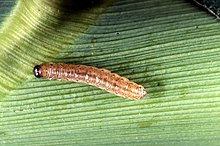| Ostrinia | |
|---|---|

| |
| Ostrinia nubialis | |
| Scientific classification | |
| Domain: | Eukaryota |
| Kingdom: | Animalia |
| Phylum: | Arthropoda |
| Class: | Insecta |
| Order: | Lepidoptera |
| Family: | Crambidae |
| Subfamily: | Pyraustinae |
| Tribe: | Pyraustini |
| Genus: | Ostrinia Hübner, 1825[1][2] |
| Synonyms | |
| |
Ostrinia is a genus of moths in the family Crambidae described by Jacob Hübner in 1825. Several of them, including the European corn borer, are agricultural pests.
Species
[edit]- Ostrinia avarialis Amsel, 1970
- Ostrinia dorsivittata (Moore, 1888)
- Ostrinia erythrialis (Hampson, 1913)
- Ostrinia furnacalis (Guenée, 1854) - Asian corn borer, Asian corn worm[3][4]
- Ostrinia kasmirica (Moore, 1888)
- Ostrinia kurentzovi Mutuura & Munroe, 1970
- Ostrinia latipennis (Warren, 1892)[4]
- Ostrinia marginalis (Walker, 1866)[2]
- Ostrinia nubilalis (Hübner, 1796) - European corn borer, European corn worm[2]
- Ostrinia obumbratalis (Lederer, 1863) - smartweed borer[2]
- Ostrinia ovalipennis Ohno, 2003[5]
- Ostrinia palustralis (Hübner, 1796)[4]
- Ostrinia penitalis (Grote, 1876) - American lotus borer[2][6]
- Ostrinia peregrinalis (Eversmann, 1852)
- Ostrinia putzufangensis Mutuura & Munroe, 1970
- Ostrinia quadripunctalis (Denis & Schiffermüller, 1775)
- Ostrinia sanguinealis (Warren, 1892)
- Ostrinia scapulalis (Walker, 1859)[3][4]
- Ostrinia zaguliaevi Mutuura & Munroe, 1970[4]
- Ostrinia zealis (Guenée, 1854)[4]
Disputed species
[edit]- Ostrinia maysalis P. Leraut, 2012, described from France.
Agricultural problems
[edit]The Asian corn borer, Ostrinia furnacalis, is one of the biggest pests of maize in Asia, causing 10%-30% of yield losses in the field, and in some cases up to 80% yield loss.[7] These pests carry fungal pathogens (such as Bipolaris maydis and Curvularia lunata) which cause diseases such as maydis leaf blight and curvularia leaf spot in the crop.
References
[edit]- ^ Nuss, M.; et al. (2003–2017). "GlobIZ search". Global Information System on Pyraloidea. Retrieved February 18, 2018.
- ^ a b c d e "Ostrinia nubialis". Integrated Taxonomic Information System. Retrieved July 6, 2007.
- ^ a b "Bugs". Systematic Reference Database on Korean Land Arthropoda. Archived from the original on 2011-07-22. Retrieved 2007-12-19. Cites Park, K. T. (1975). "Taxonomic study of the corn stem borer in Korea with allied species of the genus Ostrinia (Lep.; Pyralidae)". Korean Journal of Plant Protection. 14 (4): 221–225.
- ^ a b c d e f Kim CG, Hoshizaki S, Huang YP, Tatsuki S, Ishikawa Y (1999). "Usefulness of mitochondrial COII gene sequences in examining phylogenetic relationships in the Asian corn borer, Ostrinia furnacalis, and allied species (Lepidoptera: Pyralidae)". Applied Entomology and Zoology. 34 (4): 405–412. doi:10.1303/aez.34.405. ISSN 0003-6862.
- ^ OHNO S (2003). "A new knotweed-boring species of the genus Ostrinia Hubner (Lepidoptera: Crambidae) from Japan". Entomological Science. 6 (2): 77–83. doi:10.1046/j.1343-8786.2003.00007.x. S2CID 84384785.
- ^ "Ostrinia penitalis - "American Lotus Borer"". Archived from the original on 2007-06-10.
- ^ Wang, H., H. Dong, H. Qian, and B. Cong. "Laboratory Assessment of Entomopathogenic Nematode Symbiotic Bacteria to Control Maize Pest, Ostrinia Furnacalis, and Fungi Diseases, Bipolaris Maydis and Curvularia Lunata." Journal of Asia-Pacific Entomology. 17.4 (2014): 823-27. Scopus. Web. 7 Dec. 2014
External links
[edit]
Well, that’s interesting to know that Psilotum nudum are known as whisk ferns. Psilotum nudum is the commoner species of the two. While the P. flaccidum is a rare species and is found in the tropical islands. Both the species are usually epiphytic in habit and grow upon tree ferns. These species may also be terrestrial and grow in humus or in the crevices of the rocks.
View the detailed Guide of Psilotum nudum: Detailed Study Of Psilotum Nudum (Whisk Fern), Classification, Anatomy, Reproduction